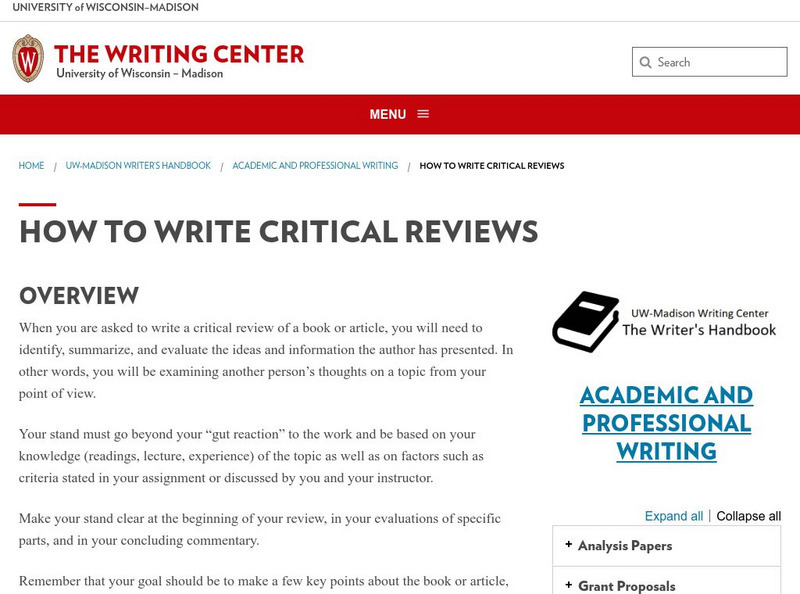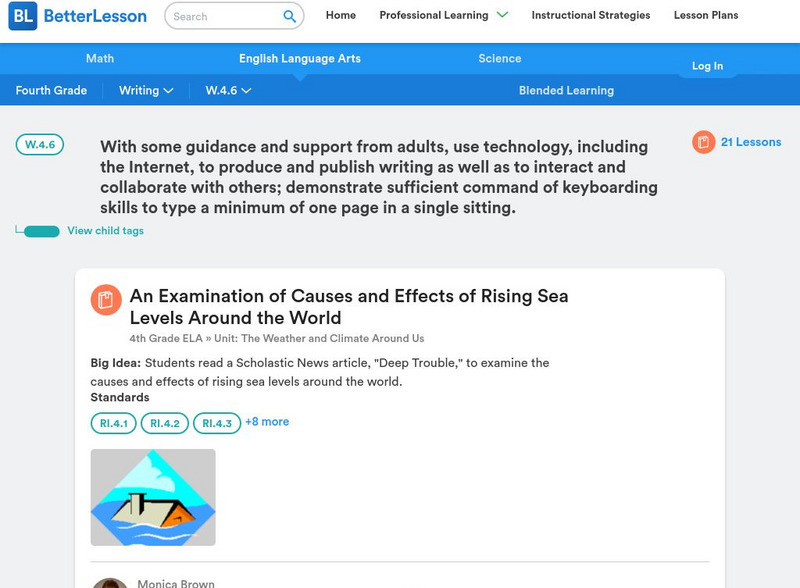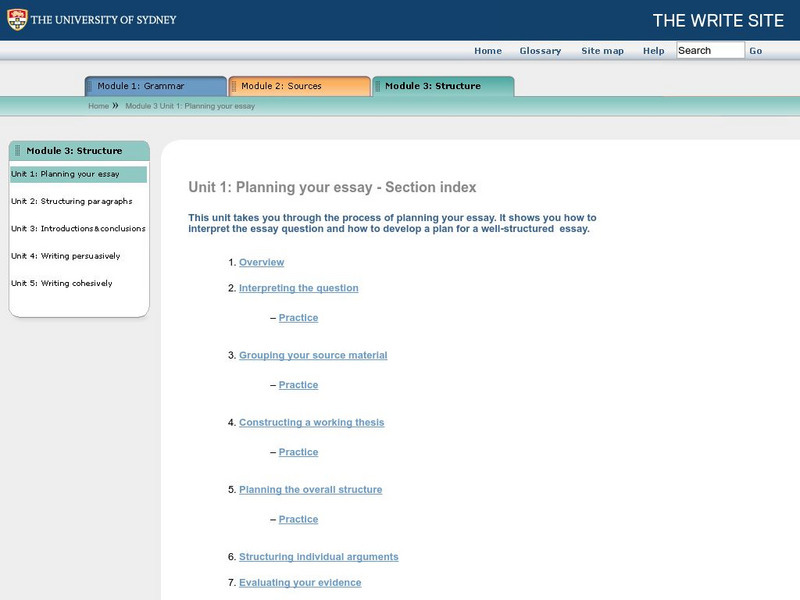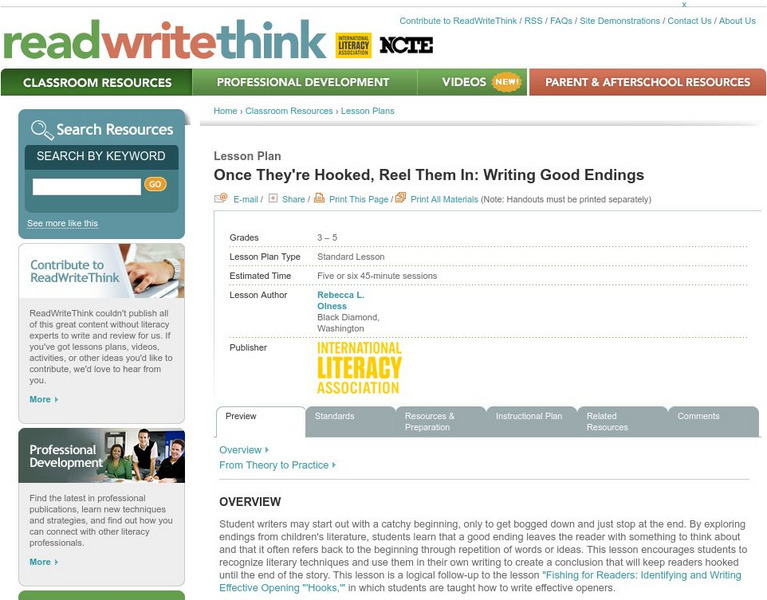Colorado State University
Colorado State Writing Center: Adapting to Your Audience
A clear guide to understanding the audience for your writing, this site leads you through steps to help you identify your audience, then structure your writing to meet that audience's needs and expectations. Use links on the right....
George Mason University
George Mason University: Writing Across the Curriculum: Teaching With Writing
Find a rationale, practices and strategies, and resources for incorporating writing in all areas of the curriculum. Learn how to write clear assignments and some methods to make grading of writing more efficient and effective....
The Write Place
Literacy Education Online: Strategies for Revising and Editing on Computers
Comprehensive discussion on how to edit material on computers. Explains how to perform functions in 2 general areas: spell check and search & replace. Also explains difference between doing this "on paper" and on computer. W.11-12.6...
University of North Carolina
University of North Carolina: Writing Center: Writing About Literature (Fiction)
Students are instructed in a nine-step process of how to write a literary response paper that includes a thesis, strong ideas, and specific supporting details from the text. W.11-12.9a Amer Lit 18th,19th, 20th cen/Analy
Sophia Learning
Sophia: Audience and Writing Style
This slideshow tutorial focuses on adjusting writing style to fit the audience. It looks at audience characteristics and discusses how to adapt the vocabulary, sentence style, and tone to fit them. It provides an example using the topic...
University of Wisconsin
University of Wisconsin Madison: Writing Center: How to Write Critical Reviews
This site provides the viewer with a step-by-step guide to writing critical reviews for non-fiction works. Its steps include analyzing the assignment as well as writing a clear introduction, body, and conclusion. Links to other writing...
ReadWriteThink
Read Write Think: Defining and Exploring an Author's Stylistic Choices
Contains plans for two lessons that teach students how to recognize an author's use of style in literature. These plans use "Their Eyes Were Watching God" by Zora Neale Hurston as an example, but the basic ideas can be adapted to other...
ReadWriteThink
Read Write Think: Avoiding Sexist Language by Using Gender Fair Pronouns
Contains plans for two lessons that teach learners how to avoid gender stereotyping while using pronouns. In addition to objectives and standards, this instructional plan contains links to sites used in the lessons as well as assessment...
ReadWriteThink
Read Write Think: Researching Information: Comparing Electronic and Print Texts
This lesson allows students to compare and contrast print text structure with that of an online site. Students work together and use worksheets in comprehending the informational text. CCSS.ELA-Literacy.WHST.6-8.7 Conduct short research...
W. W. Norton
W.w. Norton & Company: The Writing Process: Revising
Information about the process of revision including three steps to keep in mind: play the role of the reader, think in terms of strength and weakness, and take advantage of computer capabilities. Use the links on the right for other...
Better Lesson
Better Lesson: W.4.6: Use Technology to Produce and Publish Writing
Links to 21 lessons and activities that build student skills in standard W.4.6: With some guidance and support from adults, use technology, including the Internet, to produce and publish writing a well as to interact and collaborate with...
ReadWriteThink
Read Write Think: Avalanche, Aztek, or Bravada? A Connotation Minilesson
Interesting instructional activity which stresses the importance of connotation in writing by examining car names. Students participate in an interactive instructional activity in which they learn the value of connotation and begin to...
ReadWriteThink
Read Write Think: Character Clash: A Mini Lesson on Paragraphing and Dialogue
Contains plans for a minilesson that teaches about proper dialogue format while writing, specifically paragraphing. In addition to objectives and standards, this instructional plan contains links to sites used in the lessons as well as...
Education.com
Education.com: W.4.6 Worksheets: Use Technology to Produce and Publish Writing
[Free Registration/Login Required] A site with links to 6 worksheets that can be downloaded and printed for student use while building skills with standard W.4.6: With some guidance and support from adults, use technology, including the...
ReadWriteThink
Read Write Think: A Picture's Worth a Thousand Words: Image to Narrative
This lesson, which can be adapted to fit with any picture you choose, works for students of all levels.
ReadWriteThink
Read Write Think: Choosing Clear and Varied Dialogue Tags: A Minilesson
Contains plans for one 50-minute lesson that teaches about using dialogue tags like "he said" or "she answered." In addition to student objectives and standards, these instructional plans contain links to PDF handouts and links to sites...
Other
Ccss Literacy E Handbook: Informational Text: Understand Precise Vocabulary
A short explanation of the importance of using precise word choice in writing and using context clues to help you understand the meaning of precise words when reading. Click on Model to for an example with explanation and then click on...
University of Sydney (Australia)
University of Sydney: Module 3 Unit 1: Planning Your Essay
This unit index contains links with to guide students through the process of planning a multi-paragraph argumentative essay. Students will learn how to interpret the essay question, develop a writing plan, thesis, writing the argument,...
Sophia Learning
Sophia: Paper Writing: Transitions and Topic Sentences
This tutorial focuses on transitions including transitional devices, lists of common transition words and phrases, transitions between paragraphs with examples, and separate lists of transition words for descriptive, narrative, and...
Sophia Learning
Sophia: Paper Writing: Research Paper: Research Techniques
This site presents writers with information about appropriate resources to use when writing research papers and useful tips on how to find these resources. Students can read through a vocabulary section to learn the definitions of common...
Wisconsin Response to Intervention Center
Wisconsin Rt I Center: Writing to Learn [Pdf]
Teachers will learn how to use Writing to Learn as a formative assessment tool. Teachers will learn how to implement the strategy, measure progress, and find research to support writing to learn. A list of Writing to Learn activities is...
ReadWriteThink
Read Write Think: Writing Good Endings
This lesson plan explores endings and conclusions to children's literature in an attempt to teach how to successfully write a good ending. Included in the lesson plan are an overview, practice, objectives, resources, preparation, and more.
ReadWriteThink
Read Write Think: Figurative Language Awards Ceremony
Contains plans for five to seven lessons that teach about figurative language like similes, metaphors, and personification by asking students to write award acceptance speeches that incorporate them. In addition to objectives and...
Colorado State University
Colorado State Writing Center: Guide to Desktop Publishing
This resource provides information about the process of desktop publishing, including the principles of layout and design.






















